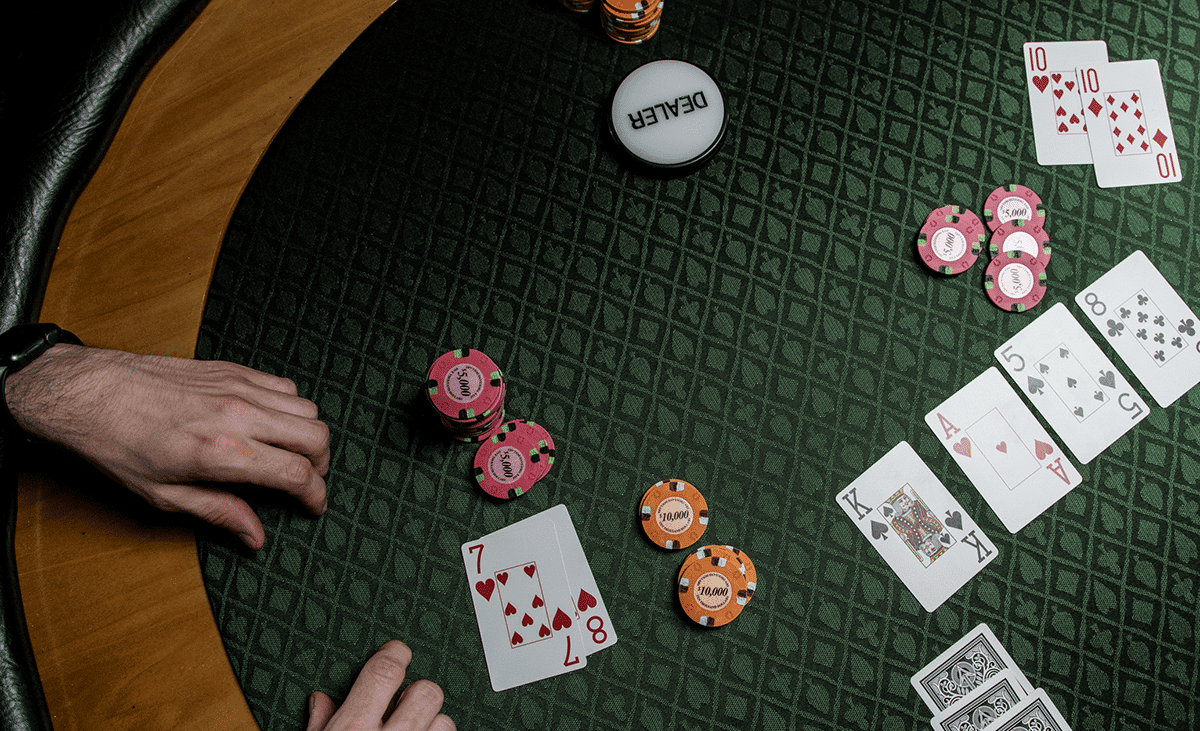The herd mentality in casino poker is strong and reveals itself particularly noticeably in both bet sizes and betting lines. At $1/$2 I doubt most players could tell you why their standard open is to $10 beyond “it’s what everyone else is doing.” I have always been somewhat puzzled by this conformity in Vegas because many games are dominated by tourists. One might expect that the great poker melting pot of The Strip would exhibit considerable diversity as players from all over the world bring in bet sizes and lines that have evolved in their home casinos. Instead it seems a consensus is transmitted throughout the broader poker-playing community, possibly in a manner analogous to the spread of winter influenza.
This situation is fortuitous for the attentive Vegas grinder. Whenever there are standardized plays in poker, some players will deviate from them under specific conditions. I imagine we have all witnessed a $10-opener suddenly launch $20 into the preflop pot, have the table fold, then slam their hand face up on the felt while announcing “I hate Jacks.” This sharing of free information strikes me as extremely public-spirited and I always try to throw out a supportive remark at such times in the hope it will encourage others to reveal how they play.

Incidentally, the fact that hands are so often shown for free in such spots illuminates part of the psychology underlying the strange behavior. People at a low-limit poker table typically like to fit in. There’s an unspoken camaraderie in many games which silently acknowledges that we, the players, are common victims of the vicious whims of The Poker Gods, and as such we should stick together. So when someone throws out an abnormal preflop bet, they feel compelled to explain to their colleagues why they stepped out of line. Again, I strongly recommend encouraging this behavior at every opportunity. The preferred response in this particular case is to nod and say “Ah yeah, Jacks”, while the table Canadian trots out the line about there being three ways to play them.
Most of these group-think plays persist for years, but every now and then a novelty appears and spreads like a successful mutation in fruit flies. I use the word “successful” loosely since the play itself is often crap, but it does succeed in temporarily integrating itself into the consensus betting lines. In the remainder of this article I’ll describe a few $1/2 novelties that emerged in Vegas in 2017 and 2018 which I suspect will persist for at least a couple of years.
Overbets.
Bets greater than the size of the pot used to be almost unheard of in $1/2 to the point where players’ attempts to avoid them were comical. Large river bets with a monster that coyly left a handful of red chips behind seemed to be motivated by the fear that an extra few bucks would sling the customer off the hook.
Here at RCP we have considerable PRO content on the topic of overbets, but I suspect the primary source for their appearance in $1/$2 games is YouTube. Table chat has alerted me to the fact that many people who are not very good at poker enjoy watching vloggers such as Doug Polk and Andrew Neeme and inevitably some ideas are trickling back into $1/$2 orthodoxy.
However, most concepts new to $1/$2 are transmitted via a process of Chinese whispers (I believe “telephone” is the American term), so that on arrival they have been significantly modified, often to the point where they are completely useless. In the case of overbets, this manifests itself in such bets always being the nuts. Thus a potentially powerful and annoying weapon in the hands of your opponents has been magically transformed into a friendly device that saves you money.
Alert readers will notice that what I’m describing here is a special case of Ed Miller’s Skill #2 from “The Course”: Don’t pay people off. However, I thought it was worth mentioning for a couple of reasons. First, despite Ed’s efforts, players at $1/$2 are still paying off large turn and river bets. Second, because overbets at low limits are currently something of a novelty, they are exactly the sort of thing that trigger some players’ suspicion response, thereby leading to an ill-advised call.
Finally, if you’ve played $1/$2 in Vegas recently and observed an overbet that was a bluff, that’s nice. Odds are the player in question is a friend of mine.
Donk bets and blind leads.
The combination of selective pattern recognition and the low number of hands per hour dealt in live poker games can make spotting trends potentially unreliable. Shortly after the 2017 WSOP I started noticing a lot of donk bets in Vegas $1/$2 games, but being somewhat intellectually honest I felt I should confirm this through a larger sample. Doug and Comrade Vape confirmed the trend. So what do they mean?
A useful reference point is the more common lead from one of the blinds in a limped pot. The standard interpretation of such a bet is a medium-strength hand such as top pair with a weak kicker. In a raised pot, the blinds or early-position limp-callers traditionally have “checked to the raiser,” partly because with a strong hand the $1/$2 convention is to check-raise the flop.
These considerations suggest that the new leads in raised pots are weakish hands, but it turns out the situation is slightly more complicated. Many of the donk bets are indeed the sort of hands that can be effectively floated and blown out of the pot on later streets. However, some players are also using this play with strong hands like flopped sets.
At first sight this might appear to be an intolerable situation in which hand-reading and exploitation are becoming more difficult, but fortunately at $1/2 the majority of players still manage to play their hands face up. The trick with these donk bets is paying attention to the bet sizing. The medium-strength one-pair type hands are bet small; typically less than half pot with some variation for an individual’s default flop bet-sizing. The big hands invariably fire out a large bet in the neighborhood of at least two-thirds pot.
The small donk bets with marginal hands, when called, are often followed by another weak bet on the turn. In fact this is one of the most common ways in which the “same bet” phenomenon I described in “Avoid And Exploit” comes about. Obviously this is great news for us since the bettor is adding more money to a pot which they have no chance of winning.
The one area where some care is required is when a large donk bet is followed by a turn check. Suppose you have enough hand to call a large donk lead even though you suspect you’re facing strength. For certain turn cards a check will often be a trap. For example, in a raised pot the big blind donks large on a Q73 two-tone flop and you decide to flat with a flush draw. If the board pairs on the turn and the big blind checks, you will frequently be facing a turned boat.
Leading draws and trap checks.
The turn trap check also crops up in another situation which is genuinely annoying since it provides tentative evidence that some $1/2 players are playing less badly; that is, taking lines which make their hands harder to read.
In both volumes of Doug Hull’s “Poker Plays You Can Use” there are examples of hands where the exploit relies to varying degrees on the fact that our opponents do not lead with their draws. At $1/2 this tendency has always been the norm, but over the last few months I have noticed an increasing number of otherwise non-threatening players betting their draws on the flop.
This in itself obviously requires some adjustment, but where I’ve really been getting burned is on the turn. Suppose we are heads-up in position on the flop having flatted with some nonsense on the button pre. Our opponent with the lead bets in flow on the two-tone flop and we float. A third flush card turns and our opponent checks. For many RCP subscribers we’ve just been given the steal sign and will fire at this pot. And then face a check-raise. The only good news is that the check-raise will invariably be large enough that we can safely fold, even on those occasions when we actually have something.
I’m not sure how widespread these turn trap checks are, and suspect I may be more susceptible to them than most people because I play aggressively postflop. But it’s in the nature of the herding mentality of $1/$2 that as more people see this play they will add it to their arsenal, so that eventually it may become part of $1/$2 orthodoxy.
That’s okay. It’s not that difficult to stay one step ahead.

The “trap check” as a new 1/2 Vegas development is interesting, as checking the nut card on the turn is fairly common everywhere. You’d know best, but it is likely a resurgence of a very old idea. More striking, however, is the idea of autobetting when checked to – this has to be one of the worst strategic recommendations to come out of the low stakes pokerosphere, in a fairly strong field of candidates. Look into that.
Well done, as usual.
Right, the trap check idea is old, it just seems to be getting used a lot more in the games I play. Interesting point about autobetting. I imagine its popularity stems from the Vegas regs tendency to c-bet too much and not barrel enough.